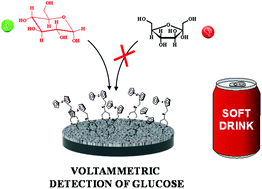Boronate-appended polymers with diol-functionalized ferrocene: an effective and selective method for voltammetric glucose sensing†
Abstract
In this research, three types of poly(amidoamine) dendrimers doped with a phenylboronic derivative at different ratios of –B(OH)2 groups to amino groups (–NH2) and one polyethyleneimine (PEI) polymer doped with a phenylboronic acid derivative were used as molecular receptors. The voltammetric glucose detection was based on the difference in the affinity of the tested systems in relation to 2-((ferrocenylmethyl)amino)propane-1,3-diol (Fc-1,3-diol) and glucose. Polymeric phenylboronic compounds were introduced to the electrode surface through an electrodeposition process at a constant potential. The obtained calibration curves were characterized by a wide range of linearity (0.005–100 μM) and low values of the limit of detection reaching even 0.0012 μM. Moreover, the influence of interferents (ascorbic acid, uric acid and fructose) was investigated at two different concentrations. Only fructose had a significant influence on the oxidation signal of ferrocene units, but solely in the case of R-Ph-B(OH)2 (where R = PEI or PAMAM; Ph – phenyl ring) systems with a low content of boron groups, and these systems form complexes with glucose in a stoichiometric ratio of 1 : 1. The reliability of the results was confirmed by determining the percentage of recovery (added glucose vs. labeled glucose). Most of the results met the acceptance criteria (95%–105%), allowing the developed electrochemical sensors to be successfully used for the analysis of real-life samples.



 Please wait while we load your content...
Please wait while we load your content...